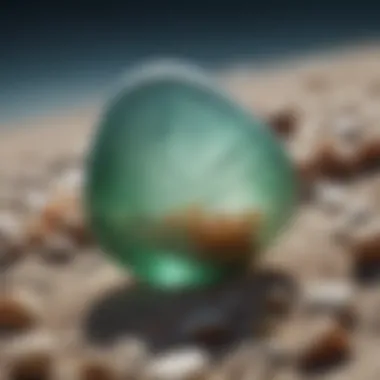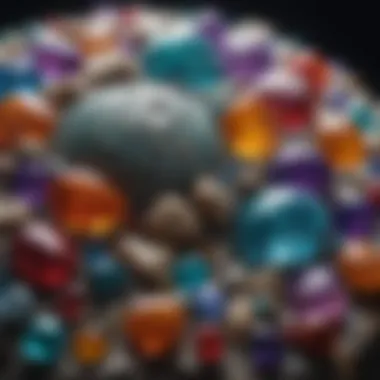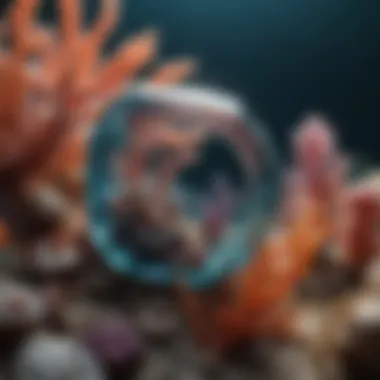Gemstones from the Sea: Discovering Marine Treasures


Intro
The realm of gemstones derived from marine environments presents a captivating intersection of geology, marine biology, and human culture. Unlike traditional gemstones sourced from terrestrial mines, marine gemstones are formed through unique geological processes in ocean settings. Their allure and value extend beyond mere aesthetics; they reflect the intricate relationship between the ocean and the creatures inhabiting it.
As we explore this niche area, one must consider the formation of these treasures. Marine gemstones originate from a variety of sources such as coral, pearls, and even certain types of shells. Each type has its defining characteristics and cultural significance. For collectors and enthusiasts, understanding these nuances is essential in appreciating the value and beauty of marine gemstones.
Furthermore, the discovery of these gemstones often intertwines with historical contexts, adding layers to their narrative. They serve as important markers of human interaction with the marine ecosystem, showcasing not only the beauty of nature but also the consequences of its exploitation.
This article will guide you through various aspects of marine gemstones, from their distinctive formation processes to their significance in different cultures. We will delve into identification techniques that collectors can utilize, ensuring a deeper connection to these extraordinary natural wonders.
Prologue to Marine Gemstones
Marine gemstones hold a distinctive position in the world of natural treasures. This section aims to lay the groundwork for the exploration into the fascinating concept of gemstones sourced from the sea. By understanding what constitutes marine gemstones, the reader can appreciate their unique formation, appearance, and the environmental factors influencing their characteristics.
Identifying and defining marine gemstones is essential. They suggest a synergy between geology and the maritime realm, out of which rare beauties emerge. The combination of oceanic elements, biological processes, and geological transformations contributes to the formation of these gems. It is this intricate process that gives rise to the diversity of gemstones found beneath the waves.
The importance of marine gemstones extends beyond their aesthetic appeal. They symbolize a connection to marine ecosystems and the need for their preservation. As collectors, enthusiasts, or simply admirers, understanding marine gemstones can deepen one's appreciation for the ocean and the treasures it harbors.
"The allure of gemstones from the sea reflects humanity’s enduring relationship with nature."
Defining Marine Gemstones
Defining marine gemstones requires an understanding of their origins. These gemstones can include not just traditional stones like pearls and coral but also unique crystals shaped by both biological and geological forces. Marine gemstones are often formed in oceanic settings, shaped by water currents, temperature, and chemical processes.
Some recognizable examples include:
- Pearls: Created by oysters and certain mollusks as a defense mechanism against irritants.
- Coral: Living organisms that harden over time. Some corals are polished to be used as gemstones.
- Aquamarine: A variety of beryl associated with the sea, often found in maritime environments.
Identifying these stones requires knowledge of their specific properties and formation processes, which differ vastly from terrestrial counterparts.
The Appeal of Gemstones from the Sea
The appeal of marine gemstones lies in their rarity and unique narratives. Collectors often seek these items not just for their beauty but for the stories they tell about the ocean and their origins. Each stone carries a history, intertwined with its environment.
Some reasons why marine gemstones attract interest include:
- Rarity: Many marine gemstones are not commonly found, enhancing their value.
- Biological Connections: They add a layer of biodiversity to a collection, reflecting the complexities of marine life.
- Cultural Significance: Many cultures assign special meanings to specific stones, influencing their desirability.
Formation of Marine Gemstones
The formation of marine gemstones encompasses distinct natural processes and oceanic influences. Understanding these dynamics is fundamental for enthusiasts and collectors alike, as they illuminate how these treasures came into being. Each gemstone is not merely a beautiful object but represents a unique story of geological and biological activity. This section aims to dissect these mechanisms, revealing their significance in the Gemstone community.
Natural Processes Involved
Marine gemstones originate through a variety of natural processes. Primarily, geological activity under the sea floor plays a critical role. Sedimentation is one core aspect; it involves the gradual accumulation of various minerals over time. For instance, the creation of pearls happens when an irritant enters a mollusk. The organism secretes layers of nacre around the irritant, culminating in a lustrous pearl.
Another important factor is crystallization. Over long periods, minerals dissolve in seawater and re-solidify. This process can yield unique crystal formations like aquamarine or tourmaline. When hot, mineral-rich water seeps through rocks, it can create new structures. This method produces gems with unique inclusions, which may enhance their value among collectors.
Key Processes of Formation:
- Sedimentation: Gradual accumulation of minerals.
- Crystallization: Dissolving and solidifying minerals in seawater.
- Biogenic Processes: Biological systems creating gemstones, like in pearls.
These natural processes contribute significantly to the diversity and beauty of marine gemstones. Collectors seek out these gemstones not just for their aesthetic appeal but for their interesting origins. Understanding the processes helps enthusiasts appreciate these gems on a deeper level.
Influence of Oceanic Conditions
Oceanic conditions are critical in shaping marine gemstones. Various factors such as water temperature, pressure, and salinity affect the growth and appearance of these treasures. For instance, cooler water temperatures can stimulate the growth of certain types of corals, which eventually transform into coral gemstones.


Moreover, tides and ocean currents can spread mineral deposits, fostering a broader distribution of specific gemstones. Regions with rich biodiversity often feature an abundance of marine gemstones. The conditions present in these environments directly influence the richness of the marine ecosystem, including the formation of gemstones.
Factors Influencing Formation:
- Water Temperature: Cooler temperatures can promote growth in various forms.
- Pressure: Affects the way minerals crystallize and form.
- Salinity Levels: Essential for biological processes.
Understanding marine gemstone formation involves both natural processes and ocean conditions, emphasizing the interconnected nature of the ocean and its treasures.
Overall, the formation of marine gemstones is a complex interplay of geological and oceanic influences. Collectors and enthusiasts benefit from this knowledge, as it enhances their understanding of these unique marine treasures. This depth of knowledge ultimately leads to a greater appreciation of the beauty and rarity of marine gemstones.
Types of Gemstones Found in Marine Environments
The ocean is a vast reservoir of natural wonders, housing a variety of gemstones that captivate both collectors and enthusiasts. Understanding the types of gemstones found in marine environments is essential in grasping their unique characteristics, allure, and ecological importance. With their varied compositions and formations, marine gemstones contribute not only to the jewelry industry but also to the biodiversity of their habitats.
Rare Oceanic Crystals
Among the treasures of the ocean, rare oceanic crystals stand out due to their distinct qualities and captivating allure. Examples include unique formations such as aquamarine and moonstone, which can sometimes be discovered on ocean floors. These crystals may form under specific conditions such as temperature and pressure levels within water. The rarity of these gemstones often increases their desirability and value in the market.
It is crucial for collectors to evaluate the authenticity and origin of these crystals. Specific processes used for extraction can impact the ethical sourcing of these gems. Moreover, understanding the geological context of where these crystals are found can enhance their narrative, making them more valuable to a collector.
Coral and Its Gemstone Forms
Coral is another fascinating form of marine gemstone. Its various colors and intricate structures can be transformed into jewelry that is both beautiful and meaningful. There are types such as red coral, blue coral, and black coral, each possessing distinct characteristics and extraction methods. Reefs are crucial to biodiversity, and the health of coral populations is indicative of oceanic environmental conditions.
However, the collection of coral gemstones raises ethical considerations. Many coral species are endangered, prompting concerns about harvesting practices. Collectors must place importance on sustainable sources when seeking coral-based jewelry. Knowledge on coral conservation initiatives is valuable for both collectors and retailers alike.
Pearls and Their Varieties
The pearl is arguably the most renowned marine gemstone, crafted by mollusks, particularly oysters and mussels. The process of pearl formation is unique; irritation within the shell prompts the mollusk to secrete layers of nacre, which eventually leads to a pearl’s growth. There are several varieties of pearls, including freshwater, saltwater, and cultured pearls. These differences not only affect their appearance but also influence their market value greatly.
Cultured pearls, in particular, have gained popularity due to advancements in aquaculture. Educating oneself about the origin and treatment of pearls is essential for quality assessment. The distinction between natural and cultured pearls can be subtle but is fundamental in determining authenticity and value. As collectors seek these exquisite gemstones, awareness of pearl sustainability practices is increasingly relevant, as excessive harvesting can lead to declines in mollusk populations.
"The ocean holds treasures beyond measure; understanding them enhances their beauty and meaning."
In summary, the diverse range of gemstones found in marine environments enriches our understanding of not just their aesthetic value, but also their ecological roles. As collectors engage with marine gemstones, it becomes imperative to navigate the complexities of collection and conservation thoughtfully.
Collecting Marine Gemstones
Collecting marine gemstones offers a unique opportunity to engage with the ocean's treasures. Identifying and gathering these gemstones can lead to a deeper appreciation of their beauty and significance. Moreover, this practice connects collectors not only with nature but also with history, art, and science. The allure of hunting for rare specimens fuels curiosity and exploration, often encouraging individuals to learn more about marine ecosystems.
Best Practices for Collecting
When embarking on the journey of collecting marine gemstones, there are essential practices to ensure the process is respectful and enjoyable. Here are several key guidelines:
- Research Locations: Identify areas known for marine gemstones. Coastal regions, riverbanks, and tide pools are excellent places to explore. Understanding local regulations will prevent any legal issues.
- Timing Matters: Go during low tide. This allows for better access to hidden gems. For specific marine life like pearls, understanding their seasonal patterns can improve collection results.
- Use Proper Tools: A sturdy bucket, gloves, and a small shovel can aid in your search. Use tools that minimize environmental disturbance while uncovering gems.
- Document Findings: Keep a journal or log of your collected items. A record can help track your collection journey and the unique characteristics of each stone.
Collecting should always be balanced with enjoyment and responsibility.
Ethical Considerations
The practice of collecting marine gemstones must include ethical considerations to protect ocean habitats. It is vital to ensure that collecting does not contribute to environmental degradation. Here are some important aspects:
- Support Sustainable Practices: Always collect gemstones in a manner that promotes sustainability. Avoid overharvesting, which can harm marine ecosystems and lead to drastic population decreases in gemstone-producing species.
- Stay Informed: Be aware of local conservation laws and guidelines concerning collecting marine organisms. Understanding which species are endangered is crucial to avoid contributing to their decline.
- Leave No Trace: Minimize your footprint by cleaning up after yourself. Any waste should be taken with you, and natural habitats should be disturbed as little as possible.
- Educate Others: Share knowledge about ethical collecting practices with fellow enthusiasts. Education fosters a sense of responsibility in preserving our oceans and their treasures.
"Collecting marine gemstones is not just about acquiring beauty; it is about engaging with our environment ethically and sustainably."
By adhering to these practices and considerations, collectors contribute positively to their hobby while respecting the ocean's delicate balance. This approach enables a harmonious connection with the natural world. Understanding how to collect responsibly ensures the ocean's treasures remain for future generations to explore and appreciate.
Cultural Significance of Marine Gemstones


Marine gemstones carry immense cultural significance across various societies. Their unique origins and attributes resonate in both artistry and folklore, creating a rich tapestry of meaning. By exploring the value placed on these oceanic treasures, we can understand their role not only in personal adornment but also in the collective heritage of humanity.
Historical Use in Jewelry
The historical applications of marine gemstones in jewelry encompass both utility and artistry. Pearls, often regarded as the most prestigious among marine gems, have a long-established reputation for enhancing the elegance of jewelry designs. For instance, in ancient Rome, pearls symbolized wealth and status. The desire to acquire pearls drove early trade routes and established them as a valuable currency.
Moreover, coral has been utilized in jewelry since prehistoric times. In various cultures, coral necklaces were believed to provide protection against evil spirits and misfortune. The bright red hues of coral were often associated with vitality and passion, endearing it to local artisans who crafted intricate designs. Collectors today still seek vintage pieces, aware of the historical context that imbues them with character and narrative.
Symbolism in Various Cultures
The symbolic interpretations of marine gemstones vary significantly among cultures. For many Indigenous peoples of the Pacific Islands, shells and coral are more than ornaments; they embody foundational spiritual beliefs. Shells, for example, are often seen as connectors between the physical and spiritual worlds. They symbolize protection and guidance, and many ceremonial items incorporate them.
In contrast, Southeast Asian cultures view pearls as symbols of purity and wisdom. In the context of marriage, they are often gifts that signify love and fidelity. The adoration for pearls extends through Asia, where they are embedded deeply in stories and rituals, highlighting their social and spiritual value.
"Marine gemstones are not just physical objects. They embody histories, beliefs, and artistic expressions intertwined with human culture across centuries."
In modern contexts, marine gemstones continue to thrive in cultural narratives. The rising interest in ethical sourcing has sparked deeper conversations about the environmental and social responsibilities associated with collecting these gems. This shift reflects a growing appreciation for both the natural world and its contribution to cultural identities.
Collectively, the historical use and symbolic meanings of marine gemstones illustrate their importance beyond mere aesthetics. They serve as a link between past and present, weaving a narrative that enriches both individual collectors and the broader community of enthusiasts who value these natural wonders.
The Role of Marine Gemstones in Ecosystems
Marine gemstones play pivotal roles within their ecosystems, providing both ecological and economic benefits. Understanding their contribution to biodiversity and the sustainability of marine habitats is essential. This section examines the intricate relationships that exist between marine gemstones and the ecosystems they inhabit.
Biodiversity and Habitat
Marine environments are rich in biodiversity. Gemstones sourced from these habitats directly contribute to the health and resilience of marine ecosystems. For instance, certain crystals, such as those found in coral reefs, serve as homes for various marine organisms. These habitats support a variety of species, from fish to mollusks, and even microscopic algae. The geology of the ocean floor influences the distribution of these gemstones, making the preservation of marine habitats critical.
Moreover, the presence of marine gemstones can be indicators of environmental health. Their existence often suggests thriving ecosystems, as they require specific conditions to form and survive. This interplay highlights the importance of gemstones as ecological assets. Thus, protecting regions rich in marine gemstones is also vital for conserving the unique biodiversity they support.
"The health of marine ecosystems can be gauged by the presence of marine gemstones, which reflect environmental conditions and biodiversity levels."
Conservation Efforts
Conservation of marine gemstones involves numerous efforts aimed at protecting both the gemstones and their habitats. Increased awareness around the impact of human activities, such as coastal development and overfishing, has led to various conservation initiatives. Organizations work to establish marine protected areas (MPAs), reducing threats to these unique environments.
Regulatory frameworks are also essential in safeguarding marine gemstones. Sustainable harvesting laws prevent the depletion of resources while allowing for the ethical collection of gemstones. Involving local communities in conservation efforts can lead to more effective protection strategies. Education programs tailored for collectors and enthusiasts help foster a sense of responsibility and understanding of the ecological significance of marine gemstones.
In summary, the conservation of marine gemstones and their habitats is crucial. It not only aids in biodiversity preservation but also ensures that future generations can appreciate these unique treasures from the sea. Sustaining the balance between ecological integrity and human activity is a shared responsibility that requires collaborative efforts.
Market Trends in Marine Gemstones
Understanding the market trends in marine gemstones is crucial for both collectors and investors. The significance of this topic lies in the shifting dynamics of the market, the evolving value of these treasures, and how they fit into broader economic and environmental contexts. Marine gemstones, while not as readily available as traditional gems, have carved out a niche that reflects changing consumer preferences, ethical considerations, and ecological awareness.
Current Valuation and Investment
The current valuation of marine gemstones hinges on several key factors. Specific gemstones such as pearls, corals, and unique sea-based minerals are subject to fluctuating prices influenced by supply and demand, rarity, and market trends. For example, rare colored pearls have witnessed ascending valuations in recent years due to limited supply and increased demand from collectors.
Investing in marine gemstones is becoming increasingly attractive. As collectors seek one-of-a-kind pieces, the perceived value of ethically sourced marine gemstones rises. This trend is notable as buyers prefer sustainable and responsibly harvested gemstones. Investors should remain informed about current market valuations and trends. They should consider the following:
- The rarity of specific stones.
- Ethical sourcing and environmental impact.
- Trends in consumer preferences.
Furthermore, the rise of online marketplaces has allowed collectors greater access to marine gems, driving up interest and potential investments.
Future Outlook and Demand
The future outlook for marine gemstones appears promising. As awareness regarding environmental sustainability grows, so does the interest in responsibly sourced gemstones. Consumers are increasingly conscious of the origins of their purchases, leading to a demand for marine gemstones that are ethically harvested.


Several indicators suggest an upward trend in demand:
- Sustainable Practices: Businesses focusing on ethical sourcing will likely see increased patronage.
- Cultural Awareness: As marine gemstones become recognized for their cultural significance, their appeal may expand beyond traditional jewelry markets.
- Technological Advances: Innovations in extraction and preservation methods could improve the availability and presentation of marine gemstones.
Overall, the market for marine gemstones is evolving. It intertwines with broader societal values and consumer trends. Collectors can anticipate a future rich with opportunities as they navigate this fascinating and complex landscape.
Care and Preservation of Marine Gemstones
Marine gemstones require specific care and preservation practices to maintain their beauty and value. These gemstones often differ from terrestrial varieties, as they can be more porous, delicate, or affected by saltwater conditions. Proper handling, cleaning, and storage can extend their longevity which is crucial for collectors and enthusiasts who recognize their worth.
Cleaning Techniques
Cleaning marine gemstones is vital to preserving their luster. Depending on the type of gemstone, cleaning methods can vary. Here are some standard techniques that can be applied:
- Gentle Soaking: Use lukewarm water mixed with a mild soap. Soak the gemstones for a few minutes to loosen debris before gently wiping them with a soft cloth.
- Soft Brush Application: A soft brush, like a toothbrush, can be useful for removing dirt from crevices. This is especially important for pearls and coral, which can trap grime in their natural textures.
- Avoid Harsh Chemicals: Do not use chemicals or abrasive materials, as they can damage the surface or finish of the gemstone. Always prioritize gentleness in your approach.
It's important to dry gemstones thoroughly after cleaning, as excess moisture can lead to mold growth or mineral deterioration over time.
Storage Recommendations
How marine gemstones are stored greatly impacts their condition. Here are some essential storage recommendations:
- Use Soft Storage Solutions: Store gemstones in soft pouches or lined boxes to prevent scratching and chipping.
- Avoid Direct Sunlight: Prolonged exposure to sunlight can fade colors in some gemstones or harm delicate structures. A cool, dark place is preferable for storage.
- Maintain Humidity Levels: Some gemstones can benefit from controlled humidity to avoid dehydration. For instance, certain types of coral may need to be kept slightly humid.
- Keep Stability in Mind: Place gemstones in a stable environment where they are not likely to be knocked about. Using compartments in jewelry boxes can help organize and protect them.
"Proper storage is almost as crucial as cleaning. Managing environmental factors like light and moisture can make the difference between a vibrant gemstone and one that deteriorates."
By implementing these care and preservation strategies, collectors can ensure that their marine gemstones remain exquisite and cherished for years to come.
Emerging Discoveries in Marine Gemstone Research
The field of marine gemstone research has grown significantly in recent years. It focuses on uncovering new methods for extraction, as well as studying the characteristics and ecological implications of these gemstones. Understanding these discoveries is vital for collectors and enthusiasts. They highlight advancements that can improve both the collection practices and the conservation of marine ecosystems.
Innovative Extraction Methods
Recent technological advancements have changed the landscape of how marine gemstones are extracted. Traditionally, divers and small-scale fishermen may have used rudimentary tools and methods that were not sustainable. Today, more sophisticated techniques are being adopted. For instance, underwater robotics and remotely operated vehicles (ROVs) allow for precise and non-invasive harvesting of gemstones from the ocean floor.
These innovations not only increase efficiency but also significantly lower the environmental impact. Reduced disturbances to marine habitats mean that extraction can happen without causing widespread damage, which is a critical factor for the sustainability of these marine resources. Additionally, researchers are focusing on developing methods that minimize the bycatch of non-target species during extraction.
Scientific Studies and Findings
Numerous recent studies have shed light on the biological and chemical properties of marine gemstones. For instance, scientists have discovered unique trace elements within certain species, which can indicate the environmental conditions in which they formed. Such findings are crucial for understanding both the gemstones themselves and the ecosystems they originate from.
Furthermore, ongoing research is revealing how marine gemstones can serve as indicators of ocean health. Coral species, for example, are not just sources of beauty but also reflect the conditions of coral reefs. The analysis of pearls and other gemstones can help in monitoring pollution levels and climate change impacts on marine habitats.
"The discoveries made about marine gemstones can influence conservation efforts and guide future research in marine ecology."
In summary, emerging discoveries in marine gemstone research are important. They highlight innovative extraction methods that are more sustainable and studies that link gemstones to broader ocean health issues. Collectors and enthusiasts ought to stay informed. This knowledge not only enhances their appreciation of these treasures but also fosters a responsible approach to their collection.
Epilogue: The Future of Marine Gemstones
The future of marine gemstones holds significant promise and potential. The ongoing exploration of oceanic areas continues to reveal unique treasures that could capture the interest of collectors and enthusiasts alike. As scientists and researchers advance in their methods, the possibilities for discovering new varieties of marine gemstones are expanding. This evolution is vital for understanding not only the physical attributes of these stones but also their ecological implications.
Technologically advanced extraction and analysis processes play a critical role in how marine gemstones are sourced. For instance, innovative techniques like 3D mapping and underwater robotics assist in locating previously hidden gems. This not only benefits collectors and investors but also promotes scientific understanding of marine biodiversity. As these methods improve, they will lead to more sustainable practices that respect marine habitats and ecosystems.
Additionally, the growing interest in sustainability drives a demand for ethically sourced stones. Collectors are increasingly focused on preserving the environment while appreciating the natural beauty of marine gemstones. Engaging in responsible collecting practices will be crucial for ensuring that future generations can enjoy these treasures.
"The protection of marine ecosystems directly influences the availability and sustainability of marine gemstones."
Summary of Key Insights
- Advances in extraction and mapping techniques are crucial in discovering new marine gemstones.
- There is a rising demand for ethically sourced marine treasures, highlighting the importance of sustainability.
- The protection of marine ecosystems will directly impact the availability of marine gemstones in the future.
Calls to Action for Enthusiasts
- Embrace responsible collecting by researching ethical sources and sustainable practices in gemstone collection.
- Stay informed about advancements in marine gemstone research and explore opportunities for involvement in conservation efforts.
- Join communities or forums, such as those found on Reddit, to connect with like-minded individuals passionate about marine gemstones.



